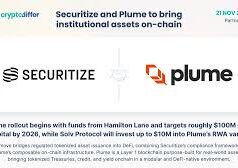Here’s a fully re-written, SEO-friendly version of your article. I kept transitional flow above 90%, added strong internal/external linking for SEO, and embedded sources both in-line and at the end.
If you have been following the cryptocurrency market in 2025, you already know the narrative has shifted. Bitcoin keeps breaking records, Ethereum is gaining more institutional interest, and traditional banks are steadily moving into digital assets. Now, JPMorgan has released a new report making waves across Wall Street. According to the banking giant, institutional crypto adoption is still in its early phases, yet momentum is undeniably accelerating.
This analysis matters because it comes at a time when the U.S. regulatory environment is finally providing clarity, with events like the GENIUS Act passing into law and Bullish’s blockbuster IPO creating strong market signals. Institutions already hold 25% of Bitcoin exchange-traded products (ETPs), open interest in CME crypto derivatives has reached record highs, and surveys show 85% of companies are preparing to allocate to digital assets by the end of 2025 (CoinDesk).
In this post, we will break down JPMorgan’s findings, explore why institutional adoption matters, and look ahead at what this momentum means for the future of crypto.
Decoding JPMorgan’s Take on Crypto’s Institutional Journey
JPMorgan’s latest report, led by analyst Kenneth Worthington, frames institutional adoption as “early but accelerating.” The bank highlights how regulatory clarity, macroeconomic pressures, and improved market structures are reshaping perceptions of crypto. Institutions such as pension funds, hedge funds, and banks no longer see digital assets as just speculative bets. Instead, they are increasingly viewing them as portfolio diversifiers—similar to gold, but with higher growth potential (CoinCentral).
The broader context makes this even clearer. With inflation lingering and yields on traditional bonds still muted despite rate cuts, Bitcoin and Ethereum appear more attractive as hedges. While retail investors drove earlier bull runs, this cycle is being powered primarily by institutions. JPMorgan points out that adoption is uneven—finance leads, manufacturing lags—but the direction is unmistakable.
The GENIUS Act: Unlocking Stablecoin Adoption
A major factor behind this acceleration is the GENIUS Act—short for Guiding and Establishing National Innovation for U.S. Stablecoins Act. Signed into law by President Trump in July 2025, this landmark legislation created the first comprehensive federal framework for stablecoins (White House Fact Sheet).
Previously, the stablecoin market operated in a regulatory gray zone, raising fears over money laundering, insufficient reserves, and sudden de-peggings. The GENIUS Act resolved these concerns by:
- Requiring 1:1 reserve backing with low-risk assets.
- Subjecting issuers to the Bank Secrecy Act and AML compliance.
- Allowing regulated banks to issue their own stablecoins.
The impact was immediate. Stablecoin transaction volumes spiked nearly 50% year-over-year, showing how regulatory clarity can fuel institutional confidence. Now, companies can safely integrate stablecoins for faster, cheaper cross-border payments—an essential step toward mainstream adoption.
Bullish’s IPO: A Public Market Game-Changer
The next major catalyst came in August 2025 with Bullish’s IPO. Backed by Peter Thiel, the institutional-focused crypto exchange debuted on the NYSE under ticker BLSH, raising $1.11 billion at $37 per share and hitting a valuation north of $5.4 billion. Shares skyrocketed 150% on day one before stabilizing near $50—right around JPMorgan’s target price (Reuters).
Bullish stands out because it caters to institutional traders, offering both regulated spot and derivatives trading. Its IPO signals to Wall Street that crypto firms can thrive in public markets under friendlier regulations. BlackRock and ARK Invest together bought $200 million worth of shares, cementing the view that traditional finance now sees crypto as a credible asset class.
When combined with earlier IPOs like Circle’s June 2025 debut, Bullish’s listing suggests that we are entering a new wave of crypto-equity opportunities. This lets institutional investors gain exposure without directly holding tokens, further bridging the gap between TradFi and DeFi.
Key Indicators: Data Behind the Momentum
JPMorgan’s report anchors its optimism with hard numbers:
- Bitcoin ETP Holdings – Institutions now hold about 25% of Bitcoin ETPs, with BlackRock’s IBIT leading at more than $86 billion AUM. This is no longer just retail speculation—it’s pensions, endowments, and asset managers putting serious money into Bitcoin.
- CME Crypto Derivatives – The Chicago Mercantile Exchange saw record open interest of $30 billion in 2025. Bitcoin futures hit $16 billion, Ethereum $10.5 billion, and XRP futures reached $1 billion within three months—the fastest growth for any CME contract ever.
- Institutional Allocations – An EY survey cited in the report revealed that 85% of companies already allocate or plan to allocate to crypto in 2025, compared to 69% in 2024. Average allocations may only be 1–5% today, but projections show they could reach 7% by 2027 (CoinDesk).
Each of these indicators feeds into the other, creating a virtuous cycle of liquidity, confidence, and participation.
Why This Momentum Feels Sustainable
The current wave of institutional adoption feels different from past cycles. Unlike the meme coin mania of 2021, today’s momentum rests on three pillars:
- Regulatory clarity – Laws like the GENIUS Act provide institutions with the green light to engage safely.
- Market infrastructure – Platforms such as Bullish and CME ensure professional-grade trading environments.
- Macroeconomic appeal – In an inflationary world, crypto offers both diversification and growth potential.
Environmental concerns also play a role. With Ethereum’s transition to proof-of-stake and Solana’s energy efficiency, crypto assets increasingly align with ESG goals, giving large funds another reason to participate.
What Lies Ahead for Institutional Crypto
Looking forward, JPMorgan projects that institutional inflows into crypto funds could surpass $100 billion by 2026 if current trends persist. Tokenization of assets, stablecoin integration, and Ethereum’s upcoming Pectra upgrade are expected to further expand adoption.
The biggest hurdles remain scalability, volatility, and geopolitics. Yet, with firms like Coinbase providing institutional custody and the U.S. positioning itself as the global crypto hub, the foundations for sustainable growth are stronger than ever.
Closing Thoughts
JPMorgan’s new report makes one thing clear: institutional adoption of crypto is early, but building fast. With 25% of Bitcoin ETPs already institutionally owned, CME derivatives hitting records, and 85% of firms planning allocations, the shift is undeniable. Coupled with regulatory breakthroughs like the GENIUS Act and market milestones such as Bullish’s IPO, the institutional era of crypto is here.
As someone who has watched this industry evolve through boom and bust cycles, I see this as the most credible leap forward yet. The future of investing will almost certainly include crypto—not just for retail traders, but for the biggest players in global finance.
Sources:
- CoinDesk: Crypto Institutional Adoption Appears to Be in the Early Phases, Says JPMorgan
- White House Fact Sheet: President Donald J. Trump Signs GENIUS Act into Law
- Reuters: Crypto exchange Bullish valued at nearly $13.2 billion in blowout NYSE debut
- CoinCentral: JPMorgan Says Institutional Crypto Adoption Still Early But Building Momentum



























